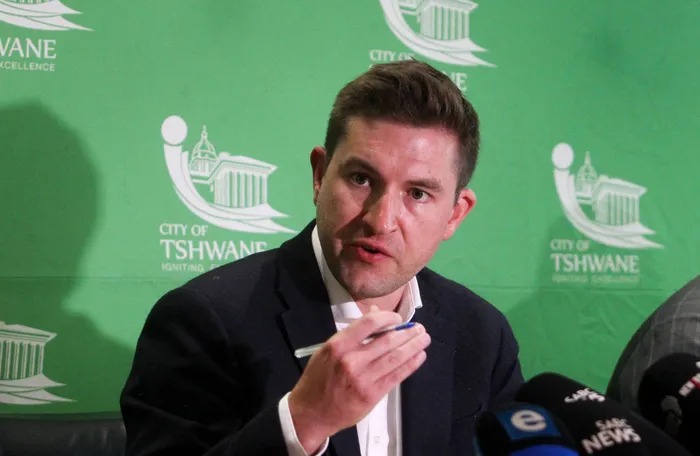Tshwane mayor’s ambitious plans to cut reliance on Eskom, and plans for national grid collapse

Bust shot of a man with Tshwane banner behind him Executive Mayor of Tshwane, Cilliers Brink addressed media on plans to cut reliance on struggling Eskom. File Picture: Jacques Naude/African News Agency(ANA)
In a bid to cut reliance from the embattled Eskom, Tshwane Mayor, Cilliers Brink on Monday announced plans for the City to generate its own electricity through a private-public cooperation plan to fire up the Rooiwal and Pretoria West power stations.
Flanked by several members of his mayoral committee, Brink said Tshwane’s energy master plan seeks to reduce the City’s dependence on Eskom and to alleviate the burden of load shedding.
“Any municipality in this country that is not answering the question - what are we going to do about load shedding - is not doing its job,” Brink said, addressing journalists.
“This is what the City of Tshwane is doing - earlier this year we appointed an energy task team, people from across departments in the City of Tshwane to look at critical issues of how we can be more independent of Eskom,” he said.
“They are looking at procuring and generating at least 1,000 megawatts of electricity in the next three years.”
He said Tshwane uses about 2,600 megawatts of electricity, so the 1,000 megawatts would have a significant impact in cutting reliance on Eskom electricity.
[STATEMENT] Tshwane Council approves public participation report to lease Rooiwal and Pretoria West Power Stations. @CityTshwane pic.twitter.com/uLM00P7Qt6
— Mayor Cilliers Brink (@tshwane_mayor) September 12, 2023
“We also have to look at the configuration of our network because if we produce our energy independent from Eskom, it has to be fed in to the network. There are technical issues that need to be looked at,” he said.
He said Tshwane is also exploring a contingency plan in the event of a total grid collapse in South Africa.
“We also have to look at what all institutions, all institutions in this country have to look at what do we do if there is a national grid collapse. There has to be disaster management plans. As unlikely as that eventuality is, if we are not preparing for it, we are not doing our job,” said Brink.
Last week, the Tshwane Council approved a public participation report for the proposed 40-year lease of the Rooiwal and Pretoria West power stations in terms of Regulation 35 of the Municipal Asset Transfer Regulations.
“These are assets that have fallen into disuse. A lot of the infrastructure still stands, but there is no real power being generated here. That has been the case since about 2012 or 2013. This facility can produce a small amount of electricity. It is not enough, and the quality of the coal it uses is poor and so you have to stockpile a whole lot of coal,” he said.
The mayor said Tshwane does not have the funds to revive the power stations, and it also does not have the credit worthiness to raise the money in the market.
“At the moment, there is a notice out for the public to comment on whether they think we should be leasing out these power stations, Pretoria West and Rooiwal, and once we have that feedback, we will make the decision on whether to lease the power stations then put out a request for proposals in the market. There is no such issue as a single supplier being chosen upfront. We need all of the potential bidders,” he said.

Meanwhile, Electricity Minister Dr Kgosientsho Ramokgopa has promised electricity supply returning back to “normality” by the end of 2024 when Eskom has completed the building and synchronisation of two additional generation units at Kusile power station in Mpumalanga.

IOL reported that Ramokgopa announced that Kusile has resumed generating 800MW at Unit 4 of Kusile after days of not a single generation unit being operational at the troubled power plant.
Kusile consists of six 800MW coal-fired generating units which could deliver a combined 4,800MW, but three units that were in service have broken down, while two others have not been synchronised to the grid.
Ramokgopa reiterated that Kusile sits on the “critical path” to significantly reducing rotational power cuts which have crippled economic activity for years.
He said the return of Unit 4 will remove 800MW from unavailable generation capacity of 4,800MW due to planned maintenance, and add those megawatts to 27,000 of available capacity, taking it to 28,500MW.
IOL